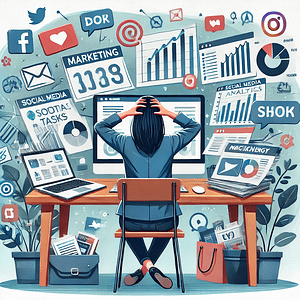Digital advertising is a driving force behind modern marketing success, with global digital ad spend expected to reach $600 billion in 2024, accounting for more than 60% of total media ad spending (source: Statista.)
With so much investment in digital advertising, businesses that master techniques like Pay-Per-Click (PPC), Programmatic Advertising, Social Media Ads, and Native Advertising can significantly increase their visibility and engagement. Each of these methods offers unique opportunities to target the right audience and maximize ROI, but knowing when and how to use them is key to maximizing their impact.
Pay-Per-Click (PPC)
Pay-Per-Click (PPC) is one of the most commonly used digital advertising strategies. In PPC campaigns, advertisers pay a fee each time someone clicks on their ad, which is typically displayed at the top of search engine results or across various platforms.
How It Works:
PPC works by targeting specific keywords that potential customers search for. Advertisers bid on these keywords in an auction-style format.
When users search for these terms, ads appear, and if clicked, the advertiser pays for the engagement. Platforms like Google Ads and Bing Ads are popular PPC networks.
Benefits:
- Immediate visibility: Ads appear right at the top of search results.
- Cost control: You only pay when someone clicks, and you can set a daily or monthly budget.
- Targeted traffic: You can control who sees your ad by specifying location, device, and even time of day.
When to Use PPC:
PPC is ideal for businesses looking for fast results and highly targeted traffic. It’s particularly effective for lead generation, product launches, or time-sensitive promotions.
- Digital ad spend is expected to reach $600 billion in 2024, accounting for 60% of total media ad spending.
- Statista
Programmatic Advertising
Programmatic advertising automates the buying and selling of ads through a real-time bidding system, enabling marketers to purchase ad space across the internet quickly and efficiently.
How It Works:
Using algorithms and data, programmatic advertising allows you to target audiences based on demographics, behavior, or browsing history. Ads are placed across websites, mobile apps, and even video platforms in real-time.
The system makes bidding decisions on your behalf, selecting the most relevant ad spaces.
Benefits:
- Efficiency: The automated process saves time, as it eliminates manual negotiation for ad placements.
- Precision targeting: Data-driven targeting ensures that ads reach the most relevant audience.
- Scalability: You can expand your reach across millions of websites and apps.
When to Use Programmatic:
This method is best for businesses seeking broad reach and precision targeting at scale.
It works well for brand awareness campaigns and large enterprises looking to efficiently manage their advertising efforts.
Programmatic advertising now accounts for 72% of all digital display ad spending.
- eMarketer
Social Media Advertising
With billions of users across platforms like Facebook, Instagram, LinkedIn, and Twitter, social media advertising provides an unparalleled opportunity to engage with your audience in a personal way.
How It Works:
Social media platforms allow advertisers to create highly targeted campaigns based on user demographics, interests, and behaviors.
Ads can appear in users’ feeds, stories, or as sponsored posts. You can run various ad formats, including video, carousel, and static image ads.
Benefits:
- Audience engagement: Social media offers a direct line to your audience, where interactions can happen in real-time.
- Flexible budgets: You can start small and scale up based on results.
- Creative formats: With multiple ad types and creative options, it’s easy to test and find what works best.
When to Use Social Media Ads:
Social media advertising is ideal for brand building, audience engagement, and remarketing to warm leads.
It works particularly well for eCommerce businesses, product promotions, and community-driven initiatives.
Businesses make an average of $2 for every $1 spent on Google Ads.
- Google Economic Impact Report
Native Advertising
Native advertising blends seamlessly with the content of the platform on which it appears, offering a non-intrusive way to promote your product or service.
How It Works:
Native ads are designed to match the look, feel, and function of the media format in which they appear, making them less disruptive.
These ads often appear as sponsored articles, recommended content, or social media posts.
Benefits:
- Higher engagement: Since native ads don’t feel like traditional ads, they tend to generate more engagement.
- Non-disruptive experience: Native ads don’t interrupt the user experience, making them more likely to be viewed.
- Trust-building: Native ads are seen as less aggressive, helping to build trust with your audience.
When to Use Native Advertising:
Native ads work best for content marketing and storytelling, where the goal is to educate or inform rather than push a hard sell. They are great for driving traffic to blog posts, videos, or long-form content.
Conclusion
Each digital advertising technique has its strengths, and the key to success lies in selecting the right strategy for your goals.
Whether you need the quick returns of PPC, the scalability of programmatic advertising, the engagement of social media ads, or the subtlety of native advertising, understanding when and how to use these tools can significantly impact your marketing success.
Sources
- Statista: Digital ad spend is expected to reach $600 billion in 2024, accounting for 60% of total media ad spending
- eMarketer: Programmatic advertising now accounts for 72% of all digital display ad spending
- Google Economic Impact Report: Businesses make an average of $2 for every $1 spent on Google Ads





